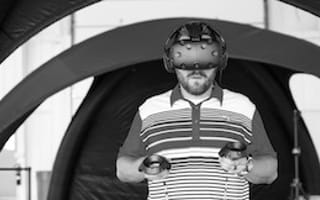
In the world of augmented and virtual reality, there’s only one constant: the suite of available tools is constantly expanding.
Spending months getting to know a brand new technology only to wake up one morning to find it obsolete might sound like an unwelcome hassle. But to the team at NEXT/NOW, a Chicago-based digital agency that specializes in emerging technologies, that challenge is part of what makes the job exciting.
“As new technology comes out, we’re looking at it, playing with it and seeing how we can fold it into what we do,” said marketing strategist Mark Matthews. “We have to be on the edge of that, because we can’t be using last year’s model when we’re trying to show people the kinds of VR experiences they can have.”
Founded in Chicago in 2011, NEXT/NOW uses VR, AR and a combination of displays and physical objects to create interactive experiences for brands like Under Armour, LG and Intel. Its work can be found in museums, flagship stores and sports stadiums around the country.
Working with emerging technologies comes with a set of engineering challenges. But spearheading new types of content presents an interesting challenge from a user experience perspective as well.
“Being early to this technology means that everyone is still trying to figure out what it all means and how it fits together,” said Matthews. “There’s a new vocabulary developing and a new style of storytelling, and you see that everyone is trying to find their niche. The game industry has their take on it and the film industry has theirs — but it’s still finding its true ground.”

To Matthews, one of the most exciting emerging trends in the space is ‘mixed reality’ devices like Microsoft’s HoloLens, which maps out the physical space surrounding a user — allowing holograms to interact with the user’s physical surroundings.
“Objects can burst out of the wall, or you can play chess with another player on a table, or a skeleton can pop up in the middle of the room and you can walk around it and learn about different structures in the body,” said Matthews. “These are things that will be pretty prolific in the next 10 years, but right now there’s only a handful of content creators.”
Although Chicago is not known for its virtual reality scene, director of business development Randy Gress said the team has been positively surprised with the quality of the local talent pool.
But recruiting for an emerging technologies team often involves looking beyond prior experience with VR and AR, and instead focusing on how experience in related fields can be applicable.
“We have a number of people with software engineering backgrounds, and we have some former game developers,” said Gress. “We also work with some folks with agency backgrounds as well, because we create all of the content in-house.”
NEXT/NOW currently has 21 employees, and it recently moved into a new office and showroom in the West Loop. The showroom is open to anyone curious about the kinds of projects NEXT/NOW is working on, Gress said.
Images via NEXT/NOW.
What's your company's story? Let us know with a tip or a tweet @BuiltInChicago






